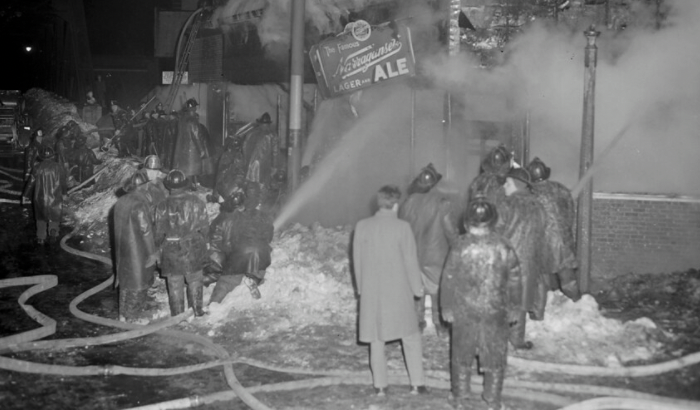
Miller helped take down the “conspiracy of nine men, including three Boston cops and a Boston firefighter” who torched everything from mills to office buildings in the early ’80s.
Dear Reader,
It was a simple, somewhat obnoxious but nevertheless fact-based tweet. Like almost every other that I spin out, a rare occurrence these days. At least compared to my past self. I have been over the thrill of getting RT’d for years; I’ve settled on the sad reality that local news, no matter how damning or gruesome, will always play fourth fiddle to celebrity nonsense, hate mongering, and bandwagoning, especially on Twitter. But back to my off-the-cuff quip, spoken into speakerphone as I pulled into a lot after passing a screaming red engine with a police appreciation flag sticking out of its backside:
Every time I see a Blue Lives Matter flag on a fire truck I think about how three Boston cops set more than 250 fires in the ’80s basically burning the city to the ground and injuring several firefighters over contract beef. And I just shake my head.
Unlike most notes to my 14,000-ish followers, maybe five of whom typically retweet me, this one … well, it caught fire. Relatively speaking, at least, compared to past performances. At the time of this writing, it’s at close to 250 RTs and four times that many likes. But I’m not just here to brag about inconsequential small potatoes milestones.
Rather, I want to first of all further suggest the 2019 book by criminal investigator Wayne M. Miller, Burn Boston Burn. It’s an utter eye-opening hellstorm throughout, packed with tales that even make a skeptical career cop critic like me cringe. Miller helped take down the “conspiracy of nine men, including three Boston cops and a Boston firefighter” who torched everything from mills to office buildings over a two-year period in the early ’80s. His writing is intense and dense, with details graphic enough to heat your hands as you furiously turn the pages. I incinerated it in two sittings, couldn’t put it down. So I guess I understand why people responded en masse to the tweet, it’s just bittersweet since many of the (admittedly less combustible) stories about unsavory cops that we report get much less traction.
In 2019, @maplecocaine coined (as far as I know) the proverb, “Each day on twitter there is one main character. The goal is to never be it.” Truer words have not been tweeted. With a lousy thousand-or-so likes, I was far from being the center of attention. I’ve catapulted close to that ball of flames before, never for anything positive, and I neither anticipate nor hope to return. But if I do, or even if I merely get another chance to reach the actual people who follow me, which is nearly impossible on any platform these days without feeding the machine like a pathetic loser who has to buy friends, it would be sweet if I could point them towards some of the outstanding work we do in the Dig.
In the meantime, I’m happy to have broken the bad news about this band of blue lives arsonists to so many new people. Even though it all went down four decades ago.
CHRIS FARAONE, EDITOR-IN-CHIEF
A Queens, NY native who came to New England in 2004 to earn his MA in journalism at Boston University, Chris Faraone is the editor and co-publisher of DigBoston and a co-founder of the Boston Institute for Nonprofit Journalism. He has published several books including 99 Nights with the 99 Percent, and has written liner notes for hip-hop gods including Cypress Hill, Pete Rock, Nas, and various members of the Wu-Tang Clan.

